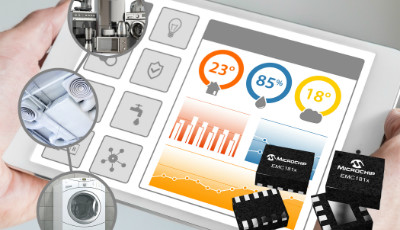Monitor temperature at multiple locations with low-power 1.8V temperature sensor family
October 08, 2018
on
on

Key Facts:
- Industry’s first rate-of-change reporting feature for temperature fluctuation measurement
- Reduces the number of sensors with two to five channels in a single temperature sensor
- Supports testable migration to 1.8V from 3.3V EMC14xx temperature sensors
- Protects against potential system failure with early notification of temperature change
Microchip announces five new 1.8V temperature sensors, including the industry’s smallest five-channel temperature sensor with standard lead spacing. The EMC181x temperature sensor family also introduces system temperature rate-of-change reporting, a feature that provides advanced warning on how the temperature of a system is fluctuating.
The temperature sensors enable designers to reduce power consumption and lower system voltage in applications such as the Internet of Things (IoT) and personal computing devices in which temperature measurement is central to functionality.
Monitoring temperature at multiple locations with a single, integrated temperature sensor reduces board complexity and simplifies design. The EMC181x temperature sensor family offers a variety of remote channels at 1.8V operation to fit different design needs, ranging from two to five channels. The family is ideal for applications migrating from 3.3V systems to lower voltage rails, such as battery-operated IoT applications, personal computing devices, Field-Programmable Gate Arrays (FPGAs) and Graphics Processing Units (GPUs). Additionally, the EMC181x family is register- and voltage-compatible with Microchip’s popular 3.3V EMC14xx temperature sensors, making migration to 1.8V testable and achievable. With the three-channel sensor available in an 8-pin 2 x 2 mm footprint and the five-channel in a 10-pin 2 x 2.5 mm footprint, the sensors can also reduce the number of devices needed for remote temperature monitoring.
With the ability to measure the system temperature rate-of-change, the EMC181x devices are the industry’s first to offer two-dimensional temperature sensing. In addition to reporting on the regular temperature, the feature notifies customers of the rate of temperature change in a system and shares data that can help to better regulate applications.
Read full article
Hide full article


Discussion (0 comments)